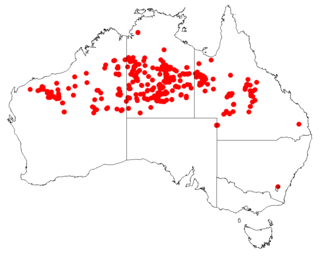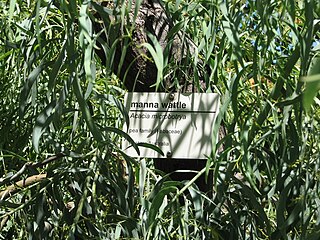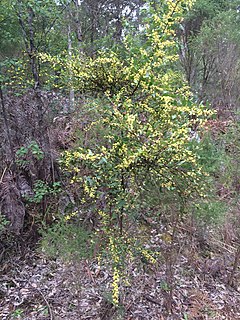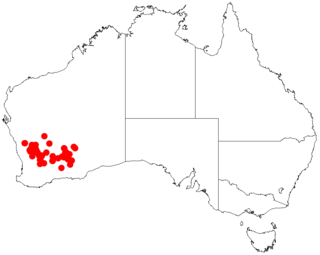
Acacia adsurgens is a shrub belonging to the genus Acacia and the subgenus Juliflorae. It is native to the northern areas of Australia.

Acacia desertorum is a shrub belonging to the genus Acacia and the subgenus Juliflorae that is endemic to western Australia.

Acacia gardneri is a shrub belonging to the genus Acacia and the subgenus Juliflorae native to Western Australia.

Acacia heteroneura is a shrub belonging to the genus Acacia and the subgenus Juliflorae that is endemic to western Australia.

Acacia hilliana, commonly known as Hill's tabletop wattle but also known as sandhill wattle and Hilltop wattle, is a shrub belonging to the genus Acacia and the subgenus Juliflorae. It is native to northern Australia.

Acacia jibberdingensis, also known as Jibberding wattle or willow-leafed wattle, is a shrub or tree belonging to the genus Acacia and the subgenus Juliflorae that is endemic to Western Australia.

Acacia neurocarpa is a shrub or tree belonging to the genus Acacia and the subgenus Juliflorae that is endemic to northern Australia.

Acacia ramulosa, commonly known as horse mulga or bowgada wattle, is a shrub belonging to the genus Acacia and the subgenus Juliflorae endemic to arid areas of Australia.

Acacia resinimarginea is a tree or shrub belonging to the genus Acacia and the subgenus Juliflorae that is endemic to western Australia.

Acacia sessilispica is a shrub belonging to the genus Acacia and the subgenus Juliflorae native to Western Australia.

Acacia symonii, also known commonly as Symon's wattle, is a tree or shrub belonging to the genus Acacia and the subgenus Juliflorae that is endemic to parts of arid central Australia.

Acacia websteri is a shrub or tree belonging to the genus Acacia and the subgenus Juliflorae that is endemic to western Australia.

Acacia camptoclada is a shrub belonging to the genus Acacia and the subgenus Phyllodineae endemic to arid parts of Western Australia.

Acacia dorsenna is a shrub belonging to the genus Acacia and the subgenus Phyllodineae that is endemic to Western Australia.

Acacia microbotrya, commonly known as manna wattle or gum wattle, is a shrub or tree belonging to the genus Acacia and the subgenus Phyllodineae that is native to Western Australia.

Acacia urophylla, commonly known as pointed leaved acacia, tall-leaved acacia, veined wattle or net-leaved wattle, is a shrub of the genus Acacia and the subgenus Phyllodineae endemic to Western Australia.

Acacia validinervia also commonly known as nyalanyalara, nyala nyala, alumaru or blue wattle, is a shrub of the genus Acacia and the subgenus Phyllodineae endemic to arid areas of inland Australia.

Acacia eremophila is a shrub of the genus Acacia and the subgenus Plurinerves that is native to Western Australia.

Acacia inceana is a shrub or tree of the genus Acacia and the subgenus Plurinerves that is endemic to south western Australia.

Acacia sclerophylla, commonly known as the hard-leaf wattle, is a shrub of the genus Acacia and the subgenus Plurinerves and is endemic to southern parts of Australia.





















